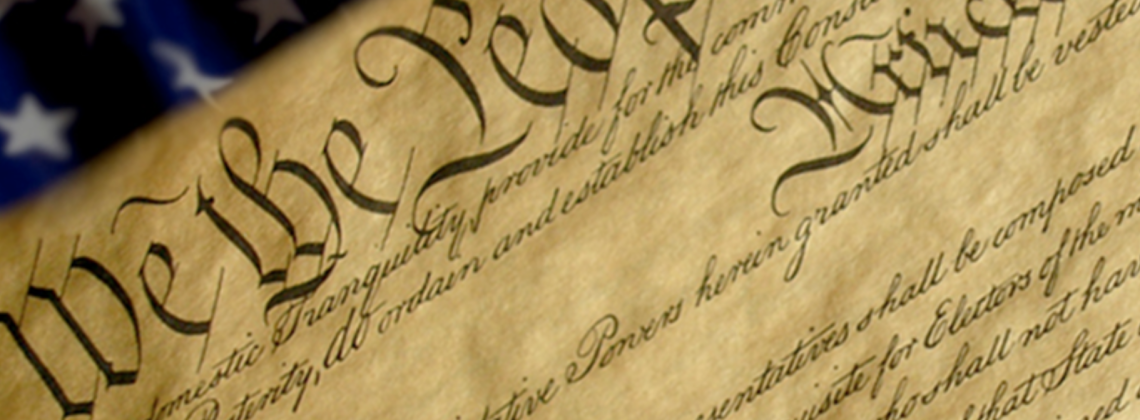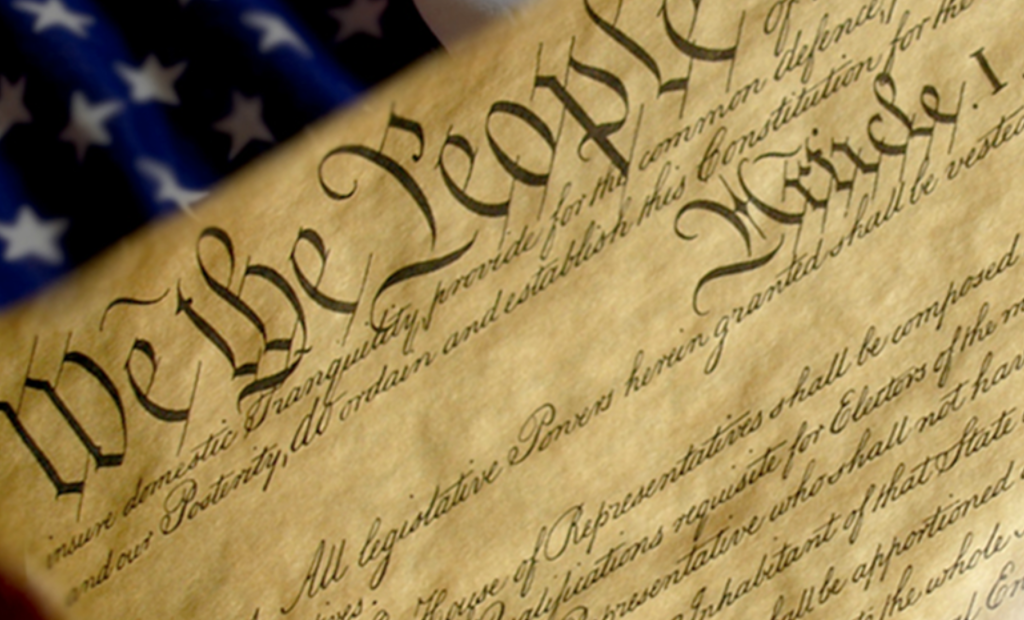

It’s not just the Constitution that haunts us
Keeping the Republic: A Defense of American Constitutionalism by Dennis Hale and Marc Landy. University Press of Kansas, 2024. 280 pp., $54.99.
What constitutes a political community? What shapes it and gives it character, making it not merely a fortified zone or a marketplace but a relationship among citizens? In Keeping the Republic, Boston College political theorists Dennis Hale and Marc Landy contend that for the United States of America the U.S. Constitution provides only partial answers to these questions: “Beyond its specific provisions for how government will work, the Constitution envisions . . . a particular way of understanding how government should be conducted, but also how citizens should live, how they should conduct their political lives.”
Governing institutions, patterns for government to follow, and a way of life for citizens: each of these layers helps to make the United States the kind of polity that it is. Hale and Landy do not describe all three of these constitutional strata with equal clarity or argue about them with equal degrees of persuasiveness. Still, despite its unevenness, their book is valuable. Above all, it invites readers not merely to parse the text of the Constitution but to think through the puzzle of what the authors call “American constitutionalism.”
Hale and Landy want to defend the Constitution against its (small-d) democratic critics while allowing for reforms within the constitutional order. To distinguish good from bad reforms, they propose the concept of the “constitutional grain.” As in woodworking, “working with the grain . . . is a way to make the end result more durable and even more attractive . . . working with the grain of the Constitution is a way to deal with the problems of modern life that comports with our deepest political principles, and with the way in which the constitutional regime was meant to operate.”
What does following this constitutional grain mean? For Hale and Landy, it involves tracking the Framers’ responses to basic features of modern politics: scale, heterogeneity, potentially overweening power. In a big country whose people share only a thin common culture, the Framers thought, political power must be both dispersed and constrained.
Insofar as the Framers got modern politics right, this argument makes sense. It is hard to imagine how a country as disparate as the United States could function without federalism. It is equally hard to imagine how citizens can live safely under a government with modern policing and administrative capabilities absent guardrails on centralized power. Hale and Landy cite a recent essay that objects to constitutionalism on the grounds that by having “some higher law that is more difficult to change than the rest of the legal order,” we “inevitably orient [ourselves] to the past and misdirect the present into a dispute over what people agreed on once upon a time.” If some political problems are perennial, however, orienting our political order toward the past is only prudent.
Nevertheless, the Framers could not have understood fully what they and other architects of political modernity unleashed. James Madison wrote that the constitutional order would foster “improvements” in transportation and communication. But he and his generation could not have anticipated the ever-accelerating pace of technological and cultural change over the coming centuries, let alone the way the Constitution’s encouragement of “commerce” would facilitate a market economy with its own potential for tyranny.
For Hale and Landy, however, neither the pace of social change nor the emergence of powerful institutions outside government elicit concerns. Rather, the Constitution’s signal feature is its resistance to “the gratification of immediate political impulses.”
Hale and Landy’s case against “impulsive democracy” is partly convincing. They sensibly argue that it is good when our institutions push us to seek complex and “durable” majorities. Whereas simple majoritarianism encourages political actors to emphasize short-term mobilization, staggered elections for different offices encourage them to organize around long-lasting and substantive areas of agreement. They are at their most eloquent when calling for a politics of deliberation and compromise—institutions that “encourage public officials to act deliberately—that is, calmly and slowly—[give them] the opportunity to think, to engage in prolonged discussion with others, to listen, and to learn.”
The problem these days, however, is that calm deliberation leading to public-spirited decision-making is exactly what our political institutions don’t produce. Hale and Landy say they want institutions that “restrain” our hastiness but don’t “obstruct” decision-making, that encourage compromise and “minimize the sense of loss on the part of those in the minority.” Yet the governing institutions they defend fulfill all too well the impulse—now prominent in our political culture—to prize self-expression over collaboration and to define victory by what we block or smash rather than by what we build.
Perhaps Hale and Landy’s chief misstep is that they neglect some of their own observations about the constitutional grain. While the Constitution may warn against impulsive democracy and (as the Anti-Federalists saw) afford citizens few opportunities for collective action, it does, nevertheless, call for representative democracy.
As Hale and Landy rightly note, representative institutions have the capacity (in the words of Madison) “to refine and enlarge the public views.” An institution like the U.S. Congress is not an antenna tuning into a pre-existing popular will. Rather, new things become possible there: an emergent general point-of-view, a deliberation taking in the whole, the generation of agreements unlikely to arise elsewhere. Might not political reform in the constitutional grain include changes that make it easier for Congress to realize such possibilities?
Focused on the dangers of impulsiveness, Hale and Landy endorse features of our constitutional order—symmetrical bicameralism, extreme disproportionality in the Senate, the Senate filibuster—that have enabled obstructionism and suppressed deliberation. But readers of Keeping the Republic who prize the constitutional principle of representation might instead conclude that abolishing the filibuster, or even amending the Constitution to render the Senate a modest “council of revision” would be excellent ways of following the constitutional grain.
The most intriguing aspect of Hale and Landy’s argument is, unfortunately, the part about which they say the least. The authors want a constitutional order in which changes, whether to policies or to institutions, follow the lines already evident in the Constitution. But by presuming that we are able to recognize that constitutional grain as a good and “attractive” pattern, they admit that some more fundamental source or standard of political goodness and beauty must underpin the constitutional order. They suggest that this substratum of American constitutionalism has something to do with “how citizens should live”—that is, with matters of civic virtue and moral formation. Yet whenever they approach such questions they seem nearly at a loss for words.
Occasionally, Keeping the Republic hints at what that citizenly way of life might be like and what we might learn from it. Objecting to the slogan “the personal is political,” Hale and Landy insist that our political loyalties should not claim our whole selves—that public life depends on another sphere of life, one which is “private” but “not . . . selfish.” They note that deliberation requires a “sense of generosity” towards fellow citizens.
Acknowledging the Anti-Federalists’ hunger for political participation, they recognize that we need to look outside the institutions of national government to find what Tocqueville called “schoolrooms of democracy.” The authors of the Federalist may have praised the Constitution’s utility in providing for “security” and “the rights of property”— that is, its encouragement of individuals in their pursuit of mere bodily well-being—but Hale and Landy remind readers that some among the Framers believed (as George Washington put it) that “virtue or morality is a necessary spring of popular government.” This is all richly suggestive. But what these hints add up to are questions that Hale and Landy do little to help their readers answer. Exactly what virtues or moral commitments or formative experiences might citizens of a modern republic need? What standards of political judgment might arise from them?
The problem is not that the authors speak of these matters sotto voce but that their whispers undermine what they say out loud. How can American politics today bridge inner life and civic experience, or school us for solidarity and generosity? Reviving our weak political parties would be the obvious place to start. But Hale and Landy allow for no objection to the Supreme Court rulings on campaign finance that have saddled us with capital-intensive, candidate-centered election campaigns, the nemesis of healthy party organizations. Reforming presidential elections and expanding access to the ballot might encourage citizens to feel that their participation matters. But Hale and Landy want to keep the Electoral College as a bulwark against our impulsiveness, and they dismiss recent voting rights bills as insufficiently federalist. Social policies designed to defend families and communities against the dislocations wrought by the market economy could stabilize the local relationships from which wider civic solidarities emerge and could build mutual caretaking into our experience of public life. Hale and Landy object to the “programmatic rights” framework of our current social welfare system, but they seem more interested in cutting social spending than in seeking better models for social policy.
Hale and Landy seem unwilling to let the needs of civic life shape our judgments of the constitutional order. Yet we need a way to think and talk about what they identify as the final stratum of all that constitutes us as a polity: our fundamental sense of “how citizens should live.”
Toward the end of C. S. Lewis’s novel That Hideous Strength a gentle old scholar of Arthurian literature named Dr. Cecil Dimble offers a curious and challenging reflection on constitutionalism. “Every people has its own haunter,” Dr. Dimble proposes: Every people can say, “We’ve heard something better than we can do, but can’t quite forget it.” Where Britain is haunted by the image of Arthur’s chivalrous kingdom of Logres, other lands are haunted by other images of the good, which they in their own ways must strive to emulate. “When Logres really dominates Britain, when the goddess Reason, the divine clearness, is really enthroned in France, when the order of Heaven is really followed in China—why, then it will be spring.”
Beneath or behind our Constitution and its grain, we Americans are together haunted by something. But what? We might recall here an image from our first founding.
In his sermon to those about to board the Arabella for America, John Winthrop charged his companions with being a “city upon a hill,” a polity whose members were to be “knit more nearly together in the bonds of brotherly affection.”
At the deepest level of what we share as a people, we Americans are constituted as a brotherly city that we are not and have never been. That city is our haunting; it is the “something” we’ve heard that is “better than we can do.” When we try to forget that city, we misunderstand not only what politics is but who we are. To remember that city, to be at home with that constitutive haunting, may require us at times to work against the grain of our dubious and far from brotherly Constitution.
Geoffrey Kurtz teaches political science and urban studies at Borough of Manhattan Community College (CUNY). His recent essays have appeared in Front Porch Republic and Public Seminar.